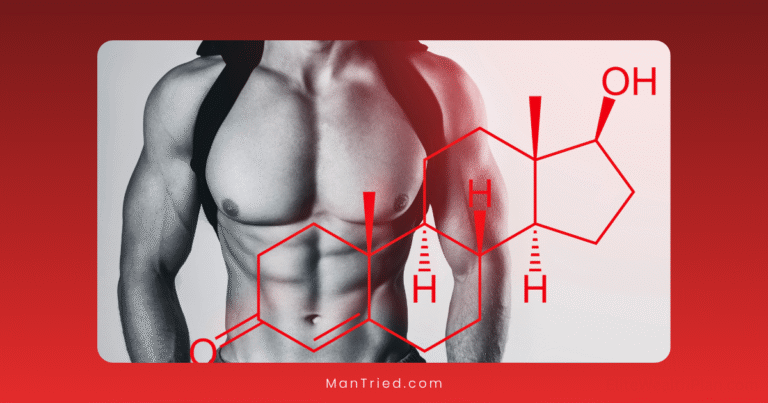Natural Ways to Boost Testosterone Levels After 40

If you’ve crossed the 40-year threshold, you might have noticed some subtle changes—perhaps a slight decline in energy, a bit more difficulty maintaining muscle mass, or a dip in your libido. These changes often have a common denominator: decreasing testosterone levels.
According to Harvard Health, testosterone levels decrease by approximately 1% each year as men age. While this decline is natural, it doesn’t mean you have to accept its effects without taking action. The good news is that numerous evidence-based, natural strategies can help maintain—and even boost—your testosterone levels after 40.
This comprehensive guide explores the most effective natural approaches to supporting healthy testosterone production as you age, without resorting to hormone replacement therapy.
Understanding Age-Related Testosterone Decline
Before diving into solutions, it’s helpful to understand what’s happening in your body. Testosterone, the primary male sex hormone, reaches its peak during early adulthood. According to research from Examine.com, levels begin to decline by 0.4% to 1.6% per year in middle-aged and older males.
By age 40, this decline becomes more noticeable, potentially affecting:
- Muscle mass and strength
- Energy levels and stamina
- Body fat distribution (especially around the midsection)
- Mood and cognitive function
- Sexual desire and performance
- Bone density
While these changes are part of the natural aging process, lifestyle factors can either accelerate or slow this decline. Let’s explore how you can naturally support your testosterone levels after 40.
The Power of Physical Activity
When it comes to natural testosterone boosters, few interventions are as powerful as regular exercise—particularly resistance training.
Resistance Training: Your Testosterone’s Best Friend
According to the University of Utah, even training twice a week for 30-40 minutes can effectively boost testosterone levels. Here’s how to maximize the testosterone-boosting benefits of your workouts:
- Focus on compound movements: Exercises that engage multiple large muscle groups—such as squats, deadlifts, bench presses, and rows—stimulate greater testosterone release than isolation exercises.
- Prioritize intensity over duration: Research indicates that moderate to high-intensity resistance training produces the most significant testosterone response. Aim for weights that challenge you in the 8-12 repetition range.
- Allow adequate recovery: Overtraining can actually decrease testosterone levels. Include 48-72 hours of recovery between training sessions for the same muscle groups.
- Include leg training: Some studies suggest that exercises involving the large muscles of the lower body may produce a more substantial hormonal response.
Mark, 47, incorporated twice-weekly resistance training sessions into his routine and noticed improvements within six weeks: “Not only did I feel stronger, but my energy levels throughout the day improved dramatically. I wasn’t expecting the boost in my mood and motivation too.”
The Role of Cardiovascular Exercise
While resistance training takes the spotlight for testosterone production, cardiovascular exercise plays a supporting role—primarily through its effects on weight management and overall health.
- HIIT (High-Intensity Interval Training): Short bursts of intense activity followed by brief recovery periods can boost testosterone more effectively than steady-state cardio. According to Healthline, HIIT can provide a significant short-term testosterone boost.
- Moderate aerobic exercise: Activities like brisk walking, cycling, or swimming for 150 minutes weekly support overall health and weight management, indirectly supporting testosterone levels.
- Avoid excessive endurance training: Marathon training or very long cardio sessions can potentially lower testosterone levels. Moderation is key.
Nutrition Strategies for Optimal Testosterone
What you eat plays a crucial role in hormone production. Here’s how to optimize your diet for testosterone support after 40:
Maintain Adequate Caloric Intake
Severe caloric restriction can lower testosterone levels. Instead of drastic diets:
- Aim for a moderate caloric deficit if weight loss is needed
- Focus on nutrient density rather than just calorie counting
- Distribute protein intake throughout the day
Optimize Macronutrients
Each macronutrient plays a role in hormone production:
- Protein: Consume 0.8-1g of protein per pound of lean body mass daily. According to WebMD, 5-6 ounces of protein from sources like lean beef, chicken, fish, eggs, and plant proteins daily supports testosterone production.
- Fats: Healthy fats are crucial for hormone production. Include sources of monounsaturated fats (olive oil, avocados) and omega-3 fatty acids (fatty fish like salmon and mackerel). Aim for 25-35% of your calories from healthy fats.
- Carbohydrates: Extremely low-carb diets may lower testosterone in some men. Include moderate amounts of complex carbohydrates, especially on training days.
Testosterone-Supporting Foods
Certain foods have been associated with higher testosterone levels:
- Oysters and shellfish: Rich in zinc, which is essential for testosterone production. One serving of oysters provides nearly five times the recommended daily zinc intake.
- Eggs: Contain protein, healthy fats, and cholesterol—all precursors for testosterone production.
- Pomegranates: Studies suggest pomegranate may lower cortisol and potentially increase testosterone.
- Cruciferous vegetables: Broccoli, cauliflower, and cabbage may help reduce estrogen’s effects in men, creating a more favorable hormonal balance.
- Onions and garlic: According to WebMD, these foods may help increase testosterone levels and improve sperm quality due to their flavonoid content.
- Magnesium-rich foods: Spinach, almonds, cashews, and peanuts can help increase usable testosterone levels by blocking a protein that binds with testosterone.
Consider a Mediterranean-Style Diet
Research consistently shows that a Mediterranean-style eating pattern supports hormonal health and weight management. This approach emphasizes:
- Abundant fruits and vegetables
- Whole grains
- Olive oil as the primary fat source
- Regular consumption of fish
- Moderate intake of dairy, eggs, and poultry
- Limited red meat and processed foods
The Critical Importance of Sleep
If you’re skimping on sleep, you’re likely undermining your testosterone levels. According to WebMD, daytime testosterone levels can drop by up to 15% with only 5 hours of sleep.
Why Sleep Matters for Testosterone
- Testosterone production peaks during sleep, particularly during REM phases
- According to University of Utah research, testosterone typically peaks around 4:00 a.m.
- Chronic sleep deprivation is associated with significantly lower testosterone levels
Sleep Optimization Strategies
- Aim for 7-9 hours of quality sleep nightly
- Maintain consistent sleep and wake times
- Create a sleep-conducive environment (dark, cool, quiet)
- Limit screen time before bed
- Consider sleep tracking to identify issues
David, 52, prioritized sleep after years of getting just 5-6 hours nightly: “Within weeks of consistently getting 7-8 hours of sleep, I noticed more morning energy and improved mood. My workout recovery improved too, which helped me build more muscle.”
Stress Management: Protecting Your Testosterone
Chronic stress elevates cortisol, which directly suppresses testosterone production. Modern life makes stress inevitable, but managing it effectively is crucial for hormonal health.
Effective Stress-Reduction Techniques
- Mindfulness meditation: Even 10-15 minutes daily can reduce stress hormones
- Deep breathing exercises: Practice 4-7-8 breathing (inhale for 4 counts, hold for 7, exhale for 8)
- Regular time in nature: “Forest bathing” has been shown to lower cortisol
- Social connection: Quality time with friends and loved ones buffers against stress
- Hobbies and leisure activities: Engaging in enjoyable activities reduces stress hormones
Strategic Supplementation
While many “testosterone-boosting” supplements lack scientific support, a few nutrients have demonstrated benefits when deficiencies exist:
Vitamin D
- Often called the “sunshine vitamin,” vitamin D functions more like a hormone
- Examine.com notes that vitamin D helps regulate testosterone levels
- Deficiency is common, especially in northern climates and among adults over 40
- Consider testing levels; supplementation of 1,000-5,000 IU daily may be beneficial if deficient
Zinc
- Essential mineral for testosterone production
- Deficiency can significantly hinder testosterone synthesis
- Food sources include oysters, beef, pumpkin seeds, and crab
- The RDA for zinc is 11 mg for males aged 19+ years
- Supplementation only beneficial if deficient; excess zinc can cause problems
Magnesium
- Supports hundreds of biochemical reactions, including testosterone production
- May increase free testosterone by reducing SHBG (Sex Hormone Binding Globulin)
- Food sources include dark chocolate, avocados, nuts, and leafy greens
- The RDA for magnesium is 400 to 420 mg for males aged 19-50 years
Ashwagandha
- An adaptogenic herb with some evidence for stress reduction and testosterone support
- May work primarily by lowering cortisol levels
- Typical effective doses range from 300-600mg daily of root extract
James, 55, discovered he was vitamin D deficient: “After three months of supplementation, my levels normalized, and I noticed improvements in my energy and strength that I hadn’t achieved through exercise alone.”
Weight Management: A Powerful Lever
Perhaps the most effective natural strategy for boosting testosterone in men over 40 is achieving and maintaining a healthy weight.
The Obesity-Testosterone Connection
- According to Examine.com, a 5% weight loss can increase total testosterone by 58 ng/dL
- A meta-analysis of 24 studies found that an average weight loss of 9.8% was associated with a testosterone increase of 84 ng/dL
- Excess body fat, especially around the midsection, converts testosterone to estrogen
Sustainable Weight Management Approaches
- Focus on gradual, sustainable weight loss (1-2 pounds weekly)
- Combine dietary changes with increased physical activity
- Address emotional and stress eating
- Consider working with a registered dietitian for personalized guidance
What to Avoid: Testosterone-Depleting Factors
Certain lifestyle factors and environmental exposures can undermine your testosterone levels:
Alcohol
- According to Harvard Health, excessive alcohol can lower testosterone and impair sexual function
- Limit intake to no more than 1-2 drinks daily, with alcohol-free days each week
Endocrine-Disrupting Chemicals
- BPA (found in some plastics) has been linked to lower testosterone
- Phthalates (found in many personal care products) may disrupt hormone production
- Consider using glass containers for food storage and checking personal care products for endocrine-disrupting chemicals
Certain Medications
- Some hair loss treatments (finasteride/Propecia) can affect testosterone levels
- Various prescription medications may impact hormone production
- Discuss concerns with your healthcare provider; never discontinue prescription medications without medical guidance
Putting It All Together: A Practical Approach
With so many strategies available, where should you start? Here’s a practical, stepwise approach:
1. Address the Foundations First
- Optimize sleep quality and duration
- Implement a sustainable exercise routine focusing on resistance training
- Adopt a Mediterranean-style eating pattern
- Manage stress effectively
2. Consider Testing
- Discuss testosterone testing with your healthcare provider
- Check for nutrient deficiencies, particularly vitamin D
- Monitor other health markers that affect testosterone (blood sugar, lipids)
3. Targeted Interventions
- Address specific deficiencies through diet or supplementation
- Focus on weight management if needed
- Reduce exposure to testosterone-depleting factors
4. Track Progress
According to the University of Utah, men can expect to see differences in testosterone levels within four to six weeks of making lifestyle changes. Monitor:
- Subjective improvements (energy, mood, libido)
- Body composition changes
- Performance metrics in the gym
- Follow-up blood work after 3-6 months
When to Seek Professional Help
While natural approaches can significantly impact testosterone levels, they’re not always sufficient. Consider consulting a healthcare provider if:
- You’ve implemented lifestyle changes for 3-6 months without improvement
- You experience severe symptoms affecting quality of life
- You have other health conditions that may complicate self-management
- Your testosterone levels are extremely low on blood tests
The Bottom Line
Age-related testosterone decline is normal, but the rate and impact of this decline are largely influenced by lifestyle factors within your control. By implementing evidence-based strategies—optimizing sleep, engaging in regular resistance training, maintaining a healthy diet and weight, managing stress, and addressing nutrient deficiencies—many men can naturally support their testosterone levels well into their 40s, 50s, and beyond.
Remember that consistency is key. These approaches work synergistically, and their benefits compound over time. Small, sustainable changes often yield better long-term results than drastic overhauls that prove difficult to maintain.
Have you tried any of these natural approaches to supporting testosterone levels? What changes have you noticed? Share your experiences in the comments below.






